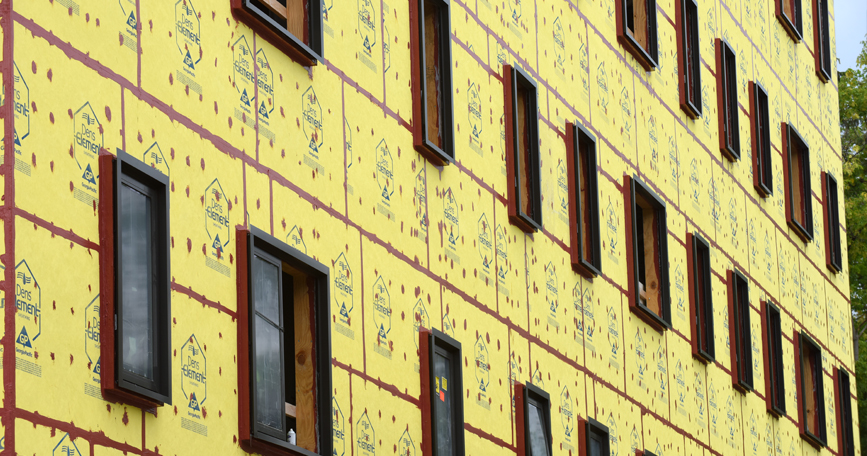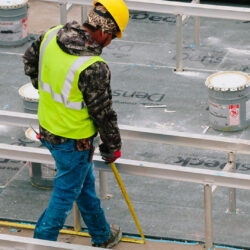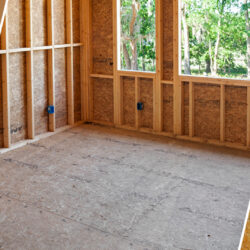A Call for Innovation
Once a city owned parking lot, the apartment complex spreads across six floors, with an average of five windows for each of the building’s 105 apartments. Sound familiar? We’re referring to the Eagles Landing DensElement® Barrier System case study in Burlington, Vermont. The one with just under 600 windows—That’s the one! Well, we decided to check in with the building envelope consultant, Zero by Degrees at the time, now known as BVH Integrated Services, upon the completion of the project to get the scoop on the performance of the DensElement® Barrier System.
Mike LaCrosse, project manager, at BVH Integrated Services, provided his feedback. He said, “I was impressed with the DensElement® Barrier System, and admittedly, my experience with the system is limited, but it seems to be a respectable product, especially in comparison against a self-adhered membrane installation.” LaCrosse added, “Due to the nature of the PROSOCO material, the entire system is what I would call a highly “inspectable” system. Meaning you can visually inspect the system and identify air leakage pathways with relative ease, even without testing it, although we prefer qualitative testing regardless. The same can be true of self-adhered membrane systems, but leakage path ways are often a bit more nuanced. With the PROSOCO, there is either a hole that leaks, or there isn’t.” Between visual inspections and qualitative testing of the DensElement® Barrier System throughout construction, LaCrosse felt confident in the building’s air tightness performance. In the end, project specifications required a quantitative test of the entire air barrier system on the building, so BVH Integrated Services performed a whole building blower door test to verify compliance with the original airtightness goal.
Some of you may be wondering, what exactly is whole building airtightness testing? ABAA explains, “Airtightness testing is a process in which the building envelope is tested to quantify the air tightness. The test measures air leakage rates through a building envelope under controlled pressurization and depressurization.” ABAA also notes that building testing is not a mandatory test prescribed in building codes, but a performance-based option that many designers are requiring. ABAA also mentions that the only requirements for whole building testing are in the State of Washington, the United States General Services Administration and all United States Army Corps of Engineers projects.
Importance of a Building’s Airtightness
The primary reason a building’s air tightness is important is first and foremost to efficiently increase indoor occupancy comfort. A truly airtight method of construction leads to greater building comfort.
An airtight building can reduce outdoor pollutants and is vital for the prevention of moisture coming into a building which can lead to mold and mildew. This is very important, especially for a job like Eagles Landing, that contained up to 600 windows. Think about it this way— A building is more likely to have an air or water leak where you cut a hole, and the more windows or rough openings, the more likely a leak can occur leading to an absence of airtightness. The tighter the airtightness in a building, the less water vapor that transmits through the envelope leading to reduced moisture infiltration levels.
Airtightness also helps with noise transmission. I think we can all agree we don’t want to be kept awake at night from the sound of cars flying by on the main highway.
There’s also a big energy efficiency component. Do you recall the time your mom or dad told you to, “Close the door behind you! Don’t let all the warm or cold air out of the house!” This is because the more you can control your energy costs, by keeping doors closed, etc., the more your utility bills will lower dramatically.

Remarkable Results
Let’s take a look at the results.
LaCrosse happily explains, “The official results after the test came out was a 0.035 CFM50 per square foot, which is considered to be incredibly tight. Typically, what BVH Integrated Services considers high performance is a 0.25 CFM50 per square foot or less. I consider “ultra-tight” construction is a .10 or less, so the building’s result of a 0.035 is a really tight number, one of the tighter numbers we’ve ever seen on a commercial building.”
To help you put the Eagles Landing airtightness results into perspective, let’s take a quick glance at the standard method for building enclosure airtightness compliance testing:
2015 International Energy Conservation Code (IECC)
0.40 cfm/ft2 (0.2 L/s · m2 ) (75 Pa)
US Army Corp of Engineers (USACE)
0.25 CFM/sq ft of flow at 75 Pa
Passive House Institute (PHI)
0.03 – 0.15 cfm/ft2 at 75
Seattle Energy Code
0.30 cfm/ft2 (1.5 L/s/m2) @ 75 Pa
When comparing the Eagles Landing results above, you’ll see the .035 result far exceeded the average standard airtightness compliance testing. Not only is using a high-performance product imperative to completing a successful project, but Lacrosse also mentions, “I think it’s also key that the builder and architect all be on board with the end goal. In the case of the Eagles Landing project, an airtight building and proper selection of materials used is one thing, but having the contractors, builder, and architect all onboard with the end goal is what carries the other half of the weight and leads to a successful project at the end of the day. The Eagles Landing project is an excellent example of what can happen when all parties of the team are committed to the end goal of the envelope.”
Continuing to Create an Element in History
“This has potential to be one of the tightest, if not the tightest, new commercial construction buildings in the state,” said LaCrosse. Within Eagles Landing’s walls, so is the DensElement™ Barrier System, a solution that can ensure a building owner of an airtight enclosure. The DensElement® Barrier System isn’t an adequate solution that just barley meets code, it’s a solution that focuses on the integrity of the building envelope and these blower door testing results speak just to that.
[1] http://www.airbarrier.org/technical-information/whole-building-air-tightness-testing-2/#1512165585438-1f3b8cd7-7cba









